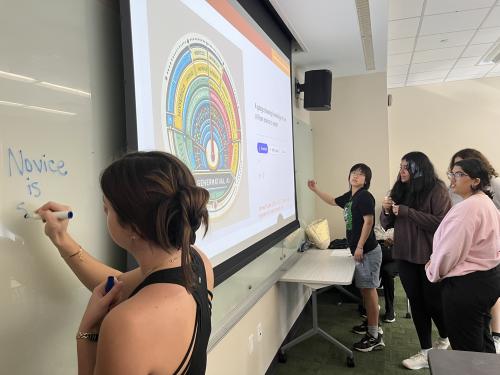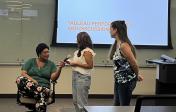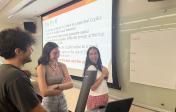Active Teaching
Excellence in teaching and learning begins with student-centered pedagogy focused on authentic community, assessment, engagement, and collaboration. For additional information about or help with any of the teaching topics below, please schedule a CATE consultation.

Rubrics for Efficient and Effective Scoring
Did you know that creating effective, descriptive rubrics in Canvas not only support student success, but make scoring quicker and more consistent?
This just-in-time CATE resource on rubrics can set your students and you up for an effective and speedier feedback process.
For more help creating and using rubrics in Canvas, schedule a CATE consultation.
Active Discussion
Active teaching allows for student ownership in the learning process as a contributor instead of a passive recipient. To fill your active teaching toolbox, CATE presents the Active Discussion series focusing on ideas for engaging students in high-level critical and creative thinking to facilitate meaningful interrogation of complex discipline topics. More active discussions are consistently being added, so return to this page periodically for new ideas!

NEW!: 4 "A"s Discussion
The 4 "A"s Discussion asks students to (1) clarify assumptions, (2) confirm agreements, (3) support arguments, and (4) imagine aspirations as they encounter new information.

Thinking Hats
The thinking hats discussion asks participants to focus their thinking systematically on multiple perspectives.

2 Cents
The idiom, “my 2 cents,” forms the foundation of this activity as students choose when and how to “spend” their academic “capital.”

Exit Tickets
Exit tickets are quick, low-stakes formative assessments for judging the level of confidence students feel about their learning.

5 Whys
Through repeated iterations of asking “why” questions, students deepen their analysis of the problem and can more clearly articulate a variety of perspectives.

Panel Discussions
Panel discussions involve a small group of experts leading a planned discussion with audience interaction to create a robust investigation of course concepts.

Tableau Activity
As a specific type of role-playing activity, tableaus offer an active, collaborative learning experience that places students physically in medias res (“in the middle of things”).

Anchor Charts
Anchor charts engage students in co-creating visual representations of the key concepts, processes, and strategies of a learning experience for class discussion.


Jigsaw Activity
The jigsaw activity supports the introduction of multiple topics in the same class period to effectively build broader and deeper understandings of various concepts.
Expand Your Active Teaching Practice
Community
Creating a positive and welcoming classroom climate, as well as using clear and regular communication, are among the most important things any instructor can do to set the tone and manage the class. One of the best ways to ensure a successful semester for you and your students is to take the time to cultivate a welcoming and supportive climate. In doing so, students are more likely to achieve the learning outcomes of the course, develop higher-order thinking skills, be motivated to learn, and be satisfied with the course (Cornelius-White, 2007; Granitz, Koernig, & Harich, 2009). Here are a few ways instructors can build a positive classroom community:
Build rapport by incorporating icebreakers early and often. For more information, see the Center for Teaching and Learning's Guide to Icebreakers with a Purpose.
Consider using a survey to learn about your students interests, goals, needs, etc.
Learn and use students’ names. Using the class photo roster in UT CLIPs is helpful!
Arrive to class a few minutes early and stay a few minutes late to make space for informal time.
Consider innovation in your teaching practice. For example, check out ideas for project-based learning (PBL) as a collaborative learning community.
Tell students that your class welcomes different viewpoints and that you will not tolerate insensitive remarks, then hold them accountable as necessary. For more information, learn about Culturally Responsive Pedagogy.
Share your enthusiasm for the subject and for their learning - excitement and positivity are contagious!
Solicit student input and feedback throughout the semester.
Set community standards and class norms.
Demonstrate and encourage social presence.
Include multiple avenues for interaction and engagement.
Model participation and behavioral expectations.
Adopt a casual, conversational tone in announcements and messages.
Allow time before, during, or after class for social conversation.
Additional Resources
Managing the Learning Environment - UT Center for Teaching and Learning
“Facilitating discourse during the course is critical to maintaining interest, motivation and engagement of students in active learning” (Anderson, et al, 2001). Communication is critical to establishing trust and fostering student engagement. Here are some important tips for communicating with students:
Plan to communicate often throughout the course. In long semesters, plan to communicate with students at least once a week, and more frequently early in the semester.
At the start of the course, tell students explicitly what to expect regarding communication, including:
your preferred method of communication (email, online discussion tool such as Teams, phone/text);
when can they expect a response from the teaching team;
when office hours are held;
if and when they will get reminders about assignments or exams, etc.
Be creative and use different modalities in your communication. For example, use the video feature in Canvas to create a video instead of a typical text announcement.
Encourage students to come to office hours and not only when they have a question about the subject matter.
Reach out individually, as possible, to students just to check in and see how they are doing. Don’t wait for them to have a problem and come to you- as we know, some never will.
When teaching, share parts of yourself. Use anecdotes and examples from your life to activate emotions. Not only do students remember good stories, they will be more likely to feel connected to you and appreciate your willingness to share.
Model active listening strategies. Communication is much clearer when we listen to understand each other! Consider using active discussion strategies as protocols for building listening skills. For example, try Thinking Hats, Jigsaw Activity, 4 As, or 2 Cents!
Additional Resources
FERPA - UT Austin
Student motivation is both intrinsic and extrinsic and can be inspired by a variety of goals including good grades, high paying jobs, social belonging, personal growth and development, and more. Not all students will be motivated by the same things or in the same ways, so it’s important to use many different motivational strategies to reach as many students as possible. Nilson (2016) provides a list of 55 Strategies for Motivating Students broken down into variety of methods including your persona, the subject matter, your teaching, and assignments and tests. Strategies include:
Getting to know your students and vice versa.
Delivering presentations with enthusiasm and energy.
Fostering good communication.
Maintaining classroom civility.
Allowing students to contribute to course content and design.
Explaining to students why you have chosen certain materials or methods.
Teaching by inquiry.
Ensuring the accessibility of materials.
Setting high expectations but realistic performance goals.
Providing prompt, regular, and positive feedback!
Giving second chances.
Allowing different options for students to demonstrate learning.
Creating community agreements and using icebreakers regularly.
Regularly soliciting feedback and input to shape and improve class.
Encouraging attendance at office hours.
Offering multiple ways to participate (hand raising, chat, discussion boards, etc.)
Using multiple means of representation, action, and expression.
Student feedback provides critical insight to support effective instructional design and delivery adjustments. Feedback is necessary during the semester to monitor ongoing growth and modify instruction accordingly. End of semester student feedback informs planning for success in future semester.
As a best practice, we suggest collecting feedback early in the semester as students will more often take time to give thoughtful, useful feedback if they know it will be incorporated into the rest of the class and impact them positively. Some ways you can solicit helpful feedback throughout the semester include:
Conduct a survey at the start of the semester to get to know students’ preferred names, pronouns, interests, learning preferences, and constraints.
Set up a designated online space, such as a Canvas discussion board, for urgent questions or FAQs. Keep adding to this throughout the semester as questions come in.
Run polls throughout the semester to get input on student well-being, attitudes, preferences, and needs.
Reinforce, at different times and through different channels (e.g., in the syllabus, in class, announcements, etc.), that you value student input and will try to make reasonable adjustments to accommodate student needs.
UT CTL has mid semester feedback resources that you can import into your Canvas course to make the collection process easier. Feel free to edit, add, or remove questions to make the survey most helpful for you.
After collecting feedback, explicitly tell students how you used their input to make adjustments to the course.
At the end of the semester, students have the opportunity to submit a Course Evaluation Survey (CES). The CES system is integrated with Canvas and appears as a tab in the left navigation of each course page. Canvas will automatically send an announcement when the course survey is open, but instructors should also send multiple reminders before it opens, while it is open, and just before it closes. In the CES system, instructors can track students’ response rates while the survey is live, personalize survey questions, add up to three additional inquiries, and access data analysis tools. To increase CES response rates, offer extra credit (individually by submitting screenshots of their completed CES or class-wide by setting a high 70-80% completion threshold) and allow class time for students to work on their CES.
Additional Resources
Share this short video about giving meaningful feedback with students.
Download UT-Austin's Response Rate Guide here.
Read more about Course Evaluations at UT Austin.
Read more about the new Course Evaluation System.
Click here to access the new Course Evaluation System.
For more information about the CES system, email course-evals@utexas.edu.
Feedback on Your Teaching - UT Center for Teaching and Learning
Teaching teams in Moody College can consist of teaching assistants or assistant instructors. Incorporating innovative practices into your work with the teaching team not only benefits current learners in your classroom, but also helps set up the next generation of teachers for success.
Set Expectations
- Meet as a group before the semester starts to clarify teaching team roles, especially for new TAs.
- Clearly communicate each member's working hours.
- Communicate expectations and guidelines for routine collaboration (e.g., grading, large classes, supervising labs, etc.).
- Hold regular meetings throughout the semester to maintain effective planning.
- Be aware of the individual factors that may impact how graduate students can succeed as TAs and AIs.
- For TAs/AIs who are non-native speakers of English, create a classroom expectation that embraces cultural wealth (Yosso) to support learning environments focused on strength-based perspectives. Emphasize the unique knowledge and skills that your TA/AI can contribute to the course content.
- As emerging professionals, support TAs/AIs to build professional practices such as clearly communicating office hours and appropriate response time to student questions.
Grading
Implementing class-wide policies instills confidence in undergraduates that they are receiving the same treatment regardless of who is grading them.
- Use clear, descriptive rubrics to calibrate scoring among the teaching team. If you need support crafting rubrics, check out our Speed Up Grading and Enhance Learning
with Effective Rubrics guide or schedule a CATE consultation. - Ensure each teaching team member knows if they have specific student assignments for scoring purposes.
- Have TAs/AIs practice scoring assignments with rubrics, then provide your feedback on the scoring before posting permanent student grades.
- Set your grade posting policy on Canvas to "manual" and decide who will post grades after all teaching team members have completed their portion of the grading. This ensures students fairly receive their grades at the same time, after all work is scored.
- Review your grade dispute policy with the teaching team and students.
- Making assignments from previous semesters available for TAs/AIs for reference is also a good practice. Consider creating a Microsoft Teams channel for your class where the teaching team can share slides, rubrics, notes, exemplary student work, etc. with future TAs/AIs.
Additional Resources
- Teaching Resources for Graduate Teaching Assistants - UT Austin Center for Teaching and Learning
Engagement
Teaching methods include all learning experiences you provide in the form of assignments and activities whether in class or outside of class. The methods you choose to teach should be based the desired result of learning as defined by your learning outcomes. Your teaching methods should also be aligned with the way you intend to assess student learning to support their successful performance.
Some teaching methods can be used to support learning outcomes at most levels of Bloom’s Taxonomy. For example, writing exercises, problem-based learning, project-based learning, and case methods can be used effectively to address most cognitive levels in Bloom’s Taxonomy. Other methods are more limited. For example, lectures and recitation support learning outcomes only at the lowest levels in Bloom’s Taxonomy. An excellent summary of teaching methods aligned to different levels of learning outcomes is available in Teaching at Its Best by Linda Nilson (2016) on page 178!
Direct instruction, or lecturing, has a place as a teaching approach. However, student-centered, active methods to promote higher order thinking and deep understanding should take precedence for most of the learning. Consider using the lecture approach sparingly to convey essential facts for foundational learning. CATE recommends the following to get the best out of lectures without over-relying on them:
Limit the scope to a few main concepts.
Pace yourself as you are speaking to limit content to key concepts.
Let your enthusiasm for the material show.
Avoid lecturing on material that is available elsewhere or duplicates other course material.
Define the learning outcomes for each lecture, and inform students of the outcomes you expect.
Make the organization clear by providing an outline.
Structure the lecture for meaningful student engagement
Use an entry event to provide context and pique student interest (e.g, 4 Corners).
Divide lectures into 10- to 15-minute chunks with time for active discussion activities in-between each chunk (e.g., Anchor Charts). Other common activities include think-pair-share, pair and compare notes, reflection or reaction paragraph, multiple-choice poll question followed by paired discussion, students write a multiple-choice test question, or a small group discussion of open-ended questions.
To conclude the lecture, provide students with the opportunity for retrieval practice to promote retention (e.g., Exit Tickets).
Lecture slides should contain minimal text focusing on high level main points. Incorporate graphics or short videos to increase engagement and illustrate concepts.
Use concrete examples to elucidate concepts and connect with real-world experience.
Planning for student engagement in class increases the likelihood that students will come prepared. Here are some ideas to proactively address preparedness:
- Begin the semester by clearly conveying the why of learning. Help students make connections between the course content and their future goals.
- When having students engage with course materials, include study questions or guidelines to help them parse out and focus on key topics/concepts.
- Use class time to engage students in active, creative, and critical application of the content, not to lecture the same material.
- Use student-centered teaching practices to increase engagement. For example, allow students to choose some readings, podcasts, or films, or ask them to lead a discussion on course content. If students helped to curate the materials or create the assignment, they’re more likely to complete it.
- Assess students regularly using low-stakes assignments such as reflections or group discussions that require them to have completed the readings before class.
- Explicitly tie activities and assessments to the course learning outcomes. This helps ensure that students understand "the point” of all the work they do.
Assessment
Assessment is about more than just assigning a grade after learning has occurred. Assessment can also be a vital part of the learning process. Keep in mind that there are different types of assessment. The two most important in teaching are
- Formative Assessment: monitoring student progress toward the learning goal and providing feedback to help students iteratively improve. Formative assessments are often no-stakes or low-stakes (ungraded, or low grade value) such as a short quiz or reflection assignment.
- Summative Assessment: evaluating whether students achieved the learning goals, i.e., assigning a grade. Summative assessments are often high stakes (and high stress) such as a final exam or final project.
As you plan how you will assess student learning, consider how you can incorporate low- or no-stakes formative assessment to help you monitor student learning, and to help students monitor their own learning. Classroom Assessment Techniques (CATs) are an easy way to integrate formative assessment into class time. With regard to summative assessment, having a small number of high-stakes assessments can increase student anxiety and their motivation to collude or cheat. Having more frequent, lower stakes assignments can reduce stress and the temptation to violate academic integrity. Additionally, more frequent deadlines prevent students from falling too far behind.
Your choice of assessment techniques should be driven by your learning outcomes (LOs)- measurable statements of what learners will be able to do as a result of learning. Well-designed learning outcomes clearly indicate the cognitive level in Bloom’s Taxonomy.
Numerous assessment techniques are available to evaluate student learning. Many instructors rely on objective quizzes and exams that typically involve multiple-choice, true-false, fill-in-the-blank, or matching questions. An advantage with these assessments is that they can be automatically graded (e.g., by Scantron or within a Canvas quiz). A limitation, however, is that these types of questions can assess learning outcomes only at the lowest cognitive levels. They cannot be used to assess ability to organize, communicate, or create.
Another commonly used assessment technique is called constructed response. This includes essay questions and writing assignments. While constructed response assignments can be used to assess learning outcomes at the higher levels of Bloom’s Taxonomy, they may require significant effort to grade. Using a clear, descriptive rubric makes grading these assignments more efficient!
Assessing learning outcomes at the highest levels of Bloom’s Taxonomy is often best achieved by performance tasks and projects that are open-ended, complex, and authentic. Authentic tasks parallel the processes and products of working professionals. Some examples include working with a real client to design an advertising campaign, conducting original research and submitting it for publication, writing a screenplay and pitching it to a production company, or creating a software training video that can be used by next semester’s students, etc. As you plan how to assess your students, consider how to make their assessment products renewable rather than disposable.
Additional Resources
- Check for Learning - UT Center for Teaching and Learning
- Creating Checks for Learning - UT Center for Teaching and Learning
We are all affected by different types of bias.
- Confirmation bias is the tendency to focus on information that supports one’s prior beliefs and values and dismiss evidence that does not support those pre existing beliefs/values.
- Implicit bias is unconscious attitudes and stereotypes associated with categories of people. Implicit bias can affect our understanding, actions, and decisions in an unconscious or unintentional manner that may be inconsistent with our conscious values.
Here are three proven strategies for minimizing bias in grading:
- Rubrics define the criteria and performance levels for grading a particular assignments. There are numerous benefits for using rubrics, including defining evaluation criteria for both learners and graders, providing a framework for giving feedback, promoting consistency if there are multiple graders, and supporting consistent grading across semesters. Creating a rubric in Canvas take a bit of time, but it saves time when grading in Speed Grader.
- Calibration is a technique for minimizing variation between grades. Graders first review and discuss the rubric. They select a sample of student submissions and all graders independently score each submission. Then they compare their results and decide what adjustments are needed. Finally, they divide the remaining submissions and complete final scoring. If a submission is difficult to score, the grader should check with the group or the grading leader.
- In blind grading, student identifiers are removed before review. It improves student belief in accuracy of assessment when they are aware of the practice. In Canvas, anonymous grading hides students’ names form the grader when viewed in SpeedGrader.
Additional Resources
- Grade Reporting - UT Austin
- Online Grade Changes - UT Austin
- FERPA - UT Austin
The purpose of feedback is to
- reinforce the learning outcome;
- confirm progress toward the outcome;
- correct misconceptions; and
- guide future learning.
The following are best practices to keep in mind when giving feedback to students:
- State your tangible observations related to the rubric criteria, not your interpretations.
- Tell students what they have done successfully and express appreciation of their ideas, connections, creativity, or conclusions!
- Be specific and include clear coaching for how to improve.
- Especially when pointing out mistakes or shortcomings, address the product, not the person (e.g., “You didn’t use APA format” vs. “The citations do not conform to APA format.")
- Use questions to identify errors (e.g., “What evidence is available to support this claim?”).
- Suggest how the student can do better next time (e.g., “In revising this report, I suggest providing at least three reasons to justify the method used.”).
Collaboration
Learning is the responsibility of the learner. However, many students do not know how to learn. Instructors can take a number of steps to teach students how to take responsibility and guide themselves through the learning process.
- When possible, encourage self-regulated learning- the process of conscious planning, monitoring, and evaluating one’s learning.
- Including lots of active learning activities followed by reflection keeps students engaged in the learning experience while facilitating the processing necessary for self-regulated learning.
- Students often use ineffective learning techniques out of habit, so it’s important to teach them effective learning techniques and help them become better learners.
- Incorporate opportunities to set goals for learning in your class and encourage connecting student's goals to the learning outcomes.
- Knowledge surveys at the beginning and the end of a course can help students see where they started and how much they grew over the semester.
- Using techniques such as minute free-writes, pair and share discussions, reflective writing assignments, and self-correcting exams gives you and your students opportunities to check in on their learning and make adjustments as needed.
- Students learn in different ways and at different paces, it’s important to give students agency and support throughout the process.
- It’s important to show compassion. Think of a time when you were learning something new and what challenges/rewards helped you through it - Use this experience to help you think of ways you can show compassion to your students.
Additional Resources
- “Learning (Your First Job)” by Robert Leamnson (2002)
- “Learning to Learn” by Karl R. Wirth and Dexter Perkins (2008b)
- Essentials of Learning - UT Center for Teaching and Learning
The benefits of group learning are numerous, including improving student productivity, critical thinking, self-esteem, intercultural relations, and interpersonal relationships. However, students often dread group work because they have been in a group that was not well-organized or had members that did not carry their weight. To avoid the potential pitfalls of group learning, it’s important to carefully structure group assignments and support group formation/organization. Group learning requires students to become active problems solvers, take risks and personal responsibility, become interdependent with their team, and see their peers and themselves as sources of knowledge. The instructor’s role also changes from being an expert provider of knowledge to being a facilitator and coach. In successful groups, members are individually accountable but interdependent. That is, each member does their fair share of the work and feels personal responsibility for the success of teammates. Below are some suggestions for group assignments to encourage interdependence and accountability.
Give groups a structured task that requires a specific product at the end. For long-term group projects, set interim deadlines for the components (e.g., pitch, outline, data collection, first draft, etc.).
Avoid assignments and projects where it’s easy to simply “divide and conquer,” otherwise, students will not reap the benefits of group learning. While you should assign (or have the group assign) each member a role or specific part of the overall task (to ensure engagement from all members), group assignments should pose a legitimate challenge that requires higher order thinking by more than one student to solve the problem. There should be multiple acceptable solutions and multiple means of reaching a solution.
Avoid letting students form their own long-term groups. Assign them to groups based on their interests or some other criteria. Take care to form groups that are heterogeneous in terms of ability, race, gender, and other characteristics. This contributes to developing social skills, helps students understand and get along with people of different backgrounds, and learn the material better.
Set expectations for respectful, professional collaboration. Explicitly discuss the qualities that make good teammates (e.g., active listening, being prepared, sharing resources, giving constructive feedback, etc.) and include those among the learning outcomes for any group assignment.
Require teams to develop and sign a team contract.
Allow time early in the semester for teams to agree on how they will carry out the work and respond to non-contributing members.
Do not require all group collaboration to occur outside of class; allow time in class for team meetings throughout the semester.
Provide information or resources to individual members so they have to share with the team.
Randomly call on different members to speak for the group.
Require all members to edit or sign off on the final product.
Give a group grade and individual grades for each member.
Provide criteria for team members to evaluate themselves and their peers, then count that evaluation in their final grade.
Additional Resources
Guide to Group Learning - UT Center for Teaching and Learning
Discussions, when effectively facilitated, help students meet learning outcomes and develop skills such as active listening, critical thinking, oral communication, and application of the information they’re learning. Consider the timing and placement of discussions in your course and prepare students to engage appropriately by setting expectations and ground rules for participation and civility. While you can use policies such as grading to encourage participation, participation will often come down to setting a positive class climate.
The Active Discussions featured on this CATE website provide detailed guidelines for conducting a wide variety of effective discussion protocols.
When it comes to difficult situations in class, anticipation and prevention are key. However, some controversial topics and challenging conversations cannot always be avoided. In fact, sometimes they should not be avoided and intentionally engaged with. Below are some tips for managing difficult classroom situations.
Establish your classroom presence with a balance of authority and approachability to set a tone of respect for you and the class.
Set class expectations and rules/norms for civil engagement early in the semester and refer back to them regularly. Consider setting these expectations collectively as a class so that students will buy in and hold each other accountable.
Ask everyone to use “I” statements and not to speak for someone else. For example, instead of saying "You aren't making any sense," say: "I'm not sure what you mean by that. Can you clarify?"
When something happens, in the moment, you can ask students to pause and reflect before engaging. This also gives you a moment to gather your composure.
It can be critical, in the moment, to acknowledge an incident and the damage it may have caused. It can be equally critical to not let it derail the class or take up unwarranted space. This will likely be a judgement call for you.
Depending on the situation, you may need to address it directly with the class or individually with the relevant students during a break or after class. Either way, be sure to follow up after class and check in with individual students as needed. You may also wish to make space during the next class period or later in the semester to address the issue in more depth as a group.
Remember that you are not alone in dealing with difficult situations and can draw on support from colleagues or CATE staff!
Additional Resources
- Academic Integrity and Classroom Expectations - Student Conduct and Academic Integrity Office of the Dean of Students, UT Austin
- UT Austin Honor Code - Office of the Executive Vice President and Provost, UT Austin
- Resolving Academic Misconduct - Student Conduct and Academic Integrity Office of the Dean of Students, UT Austin
- College Liaisons for Academic Integrity - Student Conduct and Academic Integrity Office of the Dean of Students, UT Austin
- Academic Misconduct Report Form - UT Austin
- Faculty Frequently Asked Questions for Academic Misconduct - UT Austin
- Student Conduct Report Form - UT Austin
- Senate Bill 212 Frequently Asked Questions - UT Austin
- UT Austin Title IX Office
Academic Help
- Moody Writing Support Program
- University Writing Center
- Sanger Learning Center
- Undergraduate Academic Support
Student Well-being
- Longhorn Wellness Center
- Texas Well-being In Learning Guidebook
- Texas Well-being Canvas Course
- SHIFT The Campus Culture initiative
- Counseling and Mental Health Center (CMHC)
- CMHC Texas Well-being
- CMHC Staff & Faculty Guide: Creating a Caring Culture
- CMHC Information for Faculty and Staff
- University Health Center
- Behavioral Concerns Advice Line (BCAL)
- Hogg Foundation for Mental Health
- Student Emergency Fund
- Student Emergency Services
- Class Absence Notification Request
- UT Outpost
- Victims Advocate Network
- Safety, Health and Security Resources
- LiveSafe App
- UT Night Rides
- Office of the Student Ombuds
- Office of Student Success
- Student Success Help Desk
- Division of Student Affairs

